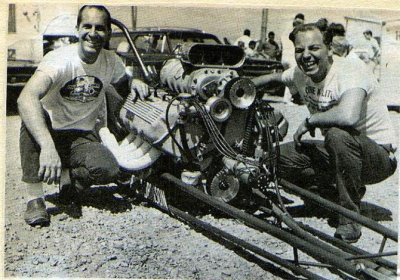The Flyweight Fairlane
 Pete and Connie Kalitta (right) pioneered SOHC 427 Ford in Top Fuel. Both shared data to cure ‘Cammer’s appetite for engine bearings. Here in 1965, posed with Pete’s car. Note minimal overspeed on blower (blower pulleys near same diameter). Both ran ‘Cammers with caution until oil system improvements were implemented. |
Robinson and Word opened 1963 much as they left 1962, with continued improvements to their proven lightweight chassis and blown small-block Chevy power. There remained some potential in the Chevy, but soon Pete’s attention was drawn to removing another 50 pounds, and doing it in what appeared to be a single sweep. The “quick weight loss diet” was a bit complicated because it entailed not only changing engine designs but engine make.
In 1960 Ford introduced an entirely new family of V-8 engines. The new engine was a small-block, 221 CID, later offered as a 260 in the Falcon Sprint, and increased again to 289 for the Ford Fairlane and the mega-popular 1965 Mustang. (Remember Wilson Pickett’s “Mustang Sally”?) The new engine incorporated new “thin-wall” casting and Pete decided the 289 could be refined into a competitive, supercharged Top Gas race engine.
After some friendly input from Ford racing engineers, Pete and Bill began building a small-block Ford V-8. The Ford’s basic internal dimensions were similar to their trusty Chevy small-block. Bored to 4.00” with a 3.50” stroker crankshaft yielded an engine of 352 cubic inches. Recently released, larger port 289 heads would also flow very close to the Chevy after porting.
The engine’s valve train was also very Chevy-like. It featured a Crane roller cam, Crane roller lifters and aluminum rockers. It also had threaded rocker arm studs, larger diameter dual valve springs, aluminum spring retainers, pushrod guide plates, heat-treated chromemoly pushrods, and lightweight 2.00” intake and 1.60” exhaust valves. All components were lightweight and the engine had the potential to rev above the 8,800 rpm mark reliably, another advantage.
The Fairlane’s oiling system was a different can of engine worms. The new Ford small-block’s rod and main bearings were frustratingly prone to failure, with disastrous consequences. Pete and Bill finally conquered the problems by machining the crankshaft main and rod bearing journals to accommodate larger bearings. A higher volume, higher pressure oil pump with a homemade, baffled oil pan were also added.
The Fairlane project ultimately equaled the performance of the Chevy, although it remained sensitive to tuning. Success with the Fairlane did bring valuable exposure with the Ford factory racing engineers. This would pay greater dividends in 1965.
The Fairlane showed promise, but when Pete and Bill needed reliable power they usually turned to their “baseline”, the trusty small-block Chevy. These were now improved with Chevy’s first 4.00” bore blocks, available in the 1962, 327 V-8. No longer was it necessary to bore a 283 from 3.875” to 4.00”, leaving perilously thin cylinder walls with marginal strength and ring sealing. The new 327 engine had a factory 4.00” bore and thicker, far more stable cylinder walls.
This was especially helpful when they sometimes stepped off into the Top Fuel ranks. Still running gas, the ultra-light car often had an advantage against brute-horsepower cars on marginal tracks. Track promoters liked matching the “Giant Killer” vs. “The Giant”, and they ran numerous match races against Top Fuelers, winning their share.
At the ’63 Nationals Pete qualified second for Top Eliminator with an 8.54, with more available. That was also the first year for the new electronic starting line lights, dubiously dubbed the “Christmas Tree”. The new ‘Tree proved to be a challenge for many drivers, including Pete. The two and one-half second interval between the ‘Tree’s flashing amber light countdown and the green light became the undoing of many. Most were alarmingly “late”.
During early AA/Dragster class eliminations Pete faced Ronnie Abbott’s Chevy-powered car. Pete somehow got “lost” in the blaze of flashing amber. Abbott’s winning ET was 9.03. Pete’s losing number was a stunning 8.66! Don Garlits’ wedge Dodge powered AA/D won the class trophy and the right to sit out Monday’s finals to face the winner of the qualified field.
On Monday Pete won Round One win over Cleveland, Ohio’s Dick Vest. Pete won with an 8.53-174.75. A former pro boxer, Vest trailed with an 8.76-175.43 in his Lakewood Chassis (Joe Schubeck), small-block Chevy powered car.
Next, Pete faced the famed “Bounty Hunter”, Connie Kalitta. Kalitta’s Mt. Clemens, Michigan, dragster was known for its ground-pounding top-end charges. Late again, Pete allowed Kalitta a huge holeshot. Conrad’s Chrysler won with an 8.69-177.86 to Pete’s tenth-quicker 8.59-175.78. The Top Eliminator final was won by 19-year-old Bobby Vodnik, driving for Kokomo, Indiana’s Phil Hobbs and Kenny Hirata. Garlits’ 413 Dodge Swamp Rat IV was runner-up.
After the ’63 Nationals Pete dedicated himself to mastering the new Christmas Tree system. Colorful, leaping flagman starts were past tense. The ‘Tree was now permanent.
Also in 1963 Pete and Bill lowered the Drag News-Standard 1320 AA/Gas Dragster ET record into the twilight zone with a 7.94-second blast, the first gas car in the sevens.
Pete and Bill’s reliance on a Dragmaster chassis also ended with the ’63 season. In early 1964 Pete and Atlanta racer Hoyt Grimes headed to California to pick up a new, modern design, Woody Gilmore chassis for the ’64 season. The car was built to mount the Chevy and the Fairlane. With its long 154” wheelbase and spindly appearance, Pete dubbed the car “Tinker Toy”, after the popular child’s wooden toy sets.
Pete and Bill ran the 1964 season in Top Gas, and ’64 would prove to be a successful year, but the writing was already on the wall, written not in gasoline, but in nitromethane.


